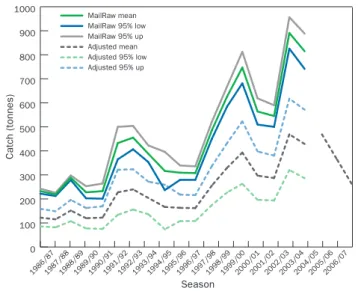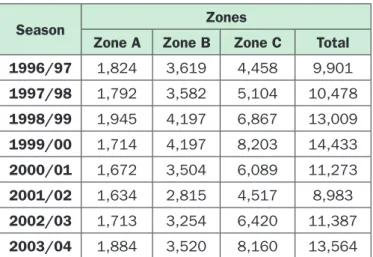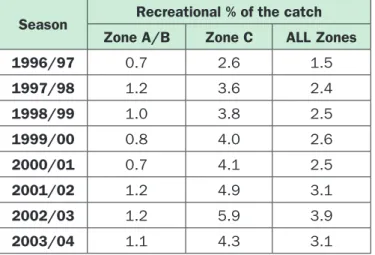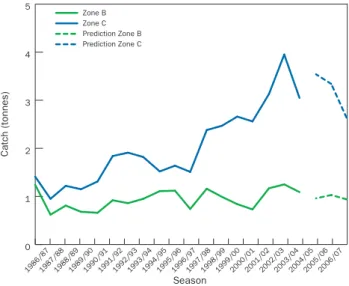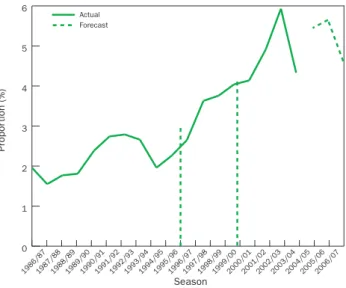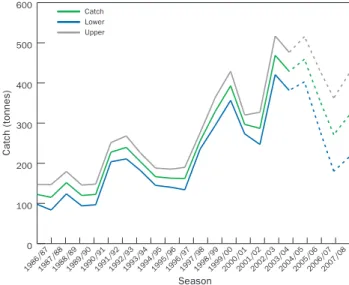This report follows IFAAC's preliminary investigation into the resource sharing issues of the western rock lobster and consultations with stakeholders. Exmouth Gulf and Augusta are the northern and southern limits of the commercial fishery - the West Coast Rock Lobster Managed Fishery (WCRLMF).
4 CATCH INFORMATION
Important additional information has become available to IFAAC since the issuance of FMP no. 192 and are listed in a Department of Fisheries document entitled Best Estimates of Western Rock Lobster. Apart from a single and relatively recent reference, there has been no specific mention of consumption of western rock lobster. Recreational catch estimates by zone using adjusted data are given in Table 2 opposite.
Estimates of the recreational share of the total western rock lobster catch in the reference period (IFM Public Policy, paragraph 19, Annex A) for all regions varied between 1.5 percent and 2.6 percent, with an average of 2.3 percent (Table 4) . For the three seasons that data have been available since 2000/2001, the recreational share of the catch has risen to between 3.1 and 3.9 percent of the total catch. Estimates of the recreational share of the catch in the reference period for Zones A/B combined ranged from 0.7 percent to 1.2 percent, with an average of 0.9 percent (Table 4).
IFAAC notes that most recreational fishing activities are in waters shallower than 18 meters.
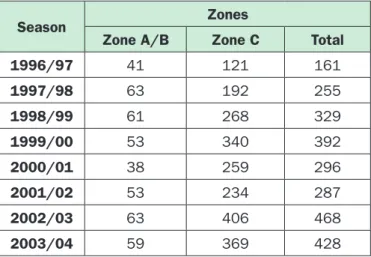
5 ALLOCATION OPTIONS
Recfishwest
Of the four options discussed above, the IFAAC prefers Option 3, which is to set the proportional catch shares at what they are expected to be in 2009/2010. Assuming that the indigenous population participates in recreational fishing at the same rate as the non-indigenous population, consumption by indigenous people would be equivalent to approximately 1.7 percent of the recreational catch. The proportion of the 1.7 per cent attributed to customary fishing by Aboriginal people is estimated by the Department of Fisheries to be around 10 per cent, based on departmental officials.
An allocation of 0.17 per cent of the recreational proportion of the catch would be equivalent to 0.0085 per cent of the total catch, assuming an allocation of 4.9 per cent to the recreational sector under option three of Table 5 . ix (see section 3.1.2), as this should be a very small percentage of the western rock lobster catches. The principle adopted by the IFAAC to deal with this matter is to make allocations as a quantity of the catch where the take is less than 0.1 percent of the proportion of the total catch.
It is important to note that since the common fishery allocation (as recommended) is a separate and very small allocation that is not currently reported, it will not have any substantial impact on the initial western lobster resource allocations for fisheries sectors commercial and recreational. .
6 ALLOCATIONS
Monitoring allocations
IFAAC recognizes that the lower percentage of crawfish catches by recreational fishermen, based on the adjusted data, may surprise some stakeholders, as the information used until recently (March 2005) comes from the unadjusted mail survey results ( see section 4.2). A few years ago, the results of the mail survey were even revised upwards in some presentations, so that sometimes even higher percentages would have been quoted. When considering allocations, the IFAAC considers it important that stakeholders have clarity on these matters.
At this stage, the telephone log survey method is believed to provide the most accurate estimate of recreational catch. If this is the case, IFAAC believes that stakeholders should be consulted before new survey techniques are adopted. The Department of Fisheries in its submission referred to the difficulty of changing data from year to year, while exploitation and catch rates vary, simply because of the variation in abundance from recruitment and the spatial distribution of each sector across the fishery.
IFAAC's view is that it was never intended that resource reallocation should respond on a real-time basis, but deal with trends in fish use towards making long-term adjustments between sectors to reflect long-term changes.
7 OTHER ISSUES
Management of allocations
The IFAAC realizes that management is a role of the Minister and the Fisheries Department. All key stakeholders have referred to the need to have appropriate management structures in place to take advantage of the opportunities IFM will bring to industries. For example, the Rock Lobster Industry Advisory Committee (RLIAC) is the statutory committee under Section 29 of the FRMA established to advise the Secretary of Fisheries on rock lobster management issues.
The RFAC is another statutory committee established under Article 33 of the FRMA that advises the Secretary of Fisheries on all recreational fisheries, including rock lobster. One of the outcomes expected to emerge from the determination of allocations under the IFM process is that each sector takes greater responsibility for maximizing the benefit of their allocation. IFAAC has made a recommendation in section 7.4 on the management of allocations up to 2009/2010, but recognizes that further policy development is needed and that the management of allocations beyond 2009/2010 requires significant policy development.
That the Executive Director of the Ministry of Fisheries, in consultation with stakeholders, develops the necessary regulatory structures to give effect to the government's IFM policies contained in Guiding Principles vii and x (see section 3.1.2).
Broader legislative arrangements
APPENDICES
Determining the Need for a Formal Allocation process in a Fishery
The Government's 2004 Integrated Fisheries Management (IFM) policy states that the Minister will set out the process and timescales for addressing allocation in each fishery based on advice from the Integrated Fisheries Allocation Advisory Committee (IFAAC). The Minister of Fisheries requested that the IFAAC begin the western rock lobster fishery, the abalone fishery and the demersal finfish fishery on the west coast. Going forward, IFAAC will consult extensively on fisheries that should be included in the IFM process and advise the Minister for Fisheries on this.
Development of an Integrated Fishery Management Fishery Report – Department
INTEGRATED FISHERIES ALLOCATION ADVISORY COMMITTEE
The Integrated Fisheries Allocation Process
The Government's 2004 Policy on Integrated Fisheries Management (IFM) states that the Minister will determine the process and timelines for resolving the allocation in each fishery based on the advice of that fishery. Once the IFAAC has reached an initial position regarding the allocation, this will be documented, together with the reasons for its conclusions, and recommended to the Minister for publication as a 'draft distribution document' for public comment, submissions invited. This stage in the process will enable those involved in fisheries, fisheries management and research, as well as those in the wider community who may have a specific interest in this fishery, to provide additional input.
Once the comment period has closed and IFAAC has considered the submissions received, IFAAC will finalize its position and submit a final award report to the Minister. The Minister for Fisheries is responsible for considering the recommendations of IFAAC and determining the allocations. The Minister has agreed to provide a statement of decision on the disclosure of his determination in an award matter.
The Minister may publish the IFAAC report at the same time as publishing its decision statement.
Mechanisms for future allocations between sectors (IFM Government Policy 1)
Depending on the circumstances of the particular fishery, IFAAC may hold or ask departmental officers to hold meetings in relevant metropolitan and regional locations to enable industry, recreational fishers and community members to input their views into the IFAAC process. In the Integrated Fisheries Management Report: Western Lobster Resource (Fisheries Management Document No. 192), the Department provided estimates of the recreational catch based on both the Department of Fisheries' postal survey and the telephone diary survey. The Integrated Fisheries Allocation Advisory Committee (IFAAC) asked me to provide a short paper on the preferred survey methodology and best estimate of recreational catches.
The attachment indicates that the telephone diary survey provides the most accurate estimate of recreational catches. The Research Department adjusted previous postal survey estimates of the recreational sector's catch taking into account the bias identified in the postal survey results. Of course, the adjustment did not change the actual (physical) size of the catch by the recreational sector - it just provided a more accurate estimate of its extent.
The Department will propose in its submission to IFAAC that the adjusted recreational catch estimate should be used as a basis for drafting IFAAC allocation recommendations to the Minister of Fisheries.
BEST ESTIMATES OF THE WESTERN ROCK LOBSTER RECREATIONAL CATCH
In Zones A&B, the recreational catch has remained almost constant at around 1% of the total catch for these zones, whereas the recreational catch in Zone C shows both annual variations and a long-term increase from 2% in the mid-80s to the current levels of 5–6% (Fig. 3). Given the current methods used to monitor the size of the WRL spawning stock, the changes in the two recreational catch estimates have virtually no impact on the assessment of the current status of this stock. The 2004/05 Alkimos puerulus settlement data also provide a preliminary indicator of the recreational catch in 2008/09, as most of the season's catch taken by the recreational sector occurs in the early part of the season (November-January).
For example, estimates of recreational catch percentages for 2008/09 to 2010/11 are based on the long-term trend in recreational effort growth under current management levels and average puerulus settlement based on the past 10 years. The forecast of the expected trend in percent of recreational catch is based on the following data sets (as requested by IFAAC): (a) 1986/87–. The recreational catch data in this paper are all based on the postal survey data adjusted for the recall bias estimated from the telephone diary survey.
Note that the proportion of recreational catch in Zone C (Figures 5 to 7) is significantly higher than that of the total fishery (Figures 2 to 4).
